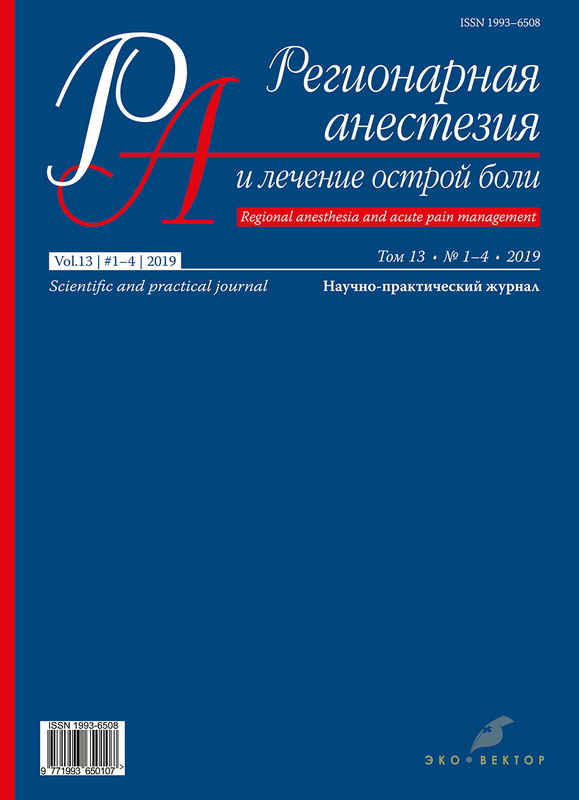Vol 13, No 1-4 (2019)
Original articles
Comparative evaluation of the effectiveness of the transdermal therapeutic system with fentanil and gabapentine in head pain therapy
Abstract
The study was conducted to comparatively evaluate the effectiveness a transdermal therapeutic system with fentanyl and gabapentin in the treatment of headache in patients with non-traumatic subarachnoid hemorrhage. When assessing the intensity of headache in patients, it was found that with severe pain immediately after endovascular occlusion, the use of transdermal fentanyl with dexketoprofen or paracetamol is most acceptable, and the combination of gabapentin with dexketoprofen / paracetamol is better in case of headache in a more delayed period.
 5-9
5-9


Demographic characteristics of patients of the center for pain treatment
Abstract
The treatment of chronic pain is one of the most important and unresolved medical problems in the world. The aim of the study was to assess the demographic characteristics of patients with chronic pain who applied to a specialized center for the treatment of pain syndromes of Federal Siberian Research Clinical Centre FMBA of Russia.
Material and methods. A retrospective analysis of 316 outpatient patient records was performed. The demographic characteristics of the patients, the frequency of types of pain syndromes and the results of the examination (PainDetect questionnaire, visual analogue scale) were evaluated.
Results. The age of patients ranged from 18 to 90 years, while patients with working age accounted for 56.7% of the total. The number of women significantly exceeded the number of men: 68.4% vs 31.6%. More than 70% of cases were diagnosed with chronic pain. 73% of patients had lower back pain, radicular and facet pain syndromes were recorded in 34.6% and 36.7%, respectively.
Conclusion. Significantly more often women sought help. 70% of patients were diagnosed with chronic pain. The most common radicular and facet pain syndromes.
 10-16
10-16


Case report
Ultrasound-guided erector spinae plane block for total hip replacement: case series
Abstract
Clinical cases of the use of ultrasound-guided Lumbar erector spinae plane block as postoperative analgesia in patients with total hip replacement. The method allows providing analgesia during the day after surgery with a minimum need for additional drug use; No side effects and complications.
 17-21
17-21


Ultrasound-guided continuous serratus anterior plane block for combined trauma: case series
Abstract
Clinical cases of the use of continuous ultrasound-guided Serratus anterior plane block in patients with severe combined trauma, dominant chest trauma and multiple rib fractures. The method allows for excellent long-term analgesia without the need for additional administration of the drug, there are no side effects.
 22-26
22-26


Accidental intravenous administration of levobupivacaine in the postoperative period
Abstract
Levobupivacin was introduced into clinical practice as a drug with a low risk of complications from the cardiovascular and central nervous system. The purpose of the report is to present a case of unintentional intravenous administration of levobupivacaine with epidural analgesia. After vertebral surgery, the patient was mistakenly injected with 10 ml of a 0.5% solution of levobupivacaine. Clinically, systemic toxicity was manifested only in mild euphoria. After lipid resuscitation, the patient’s condition improved. Despite the successful outcome of the clinical case, the anesthesiologist must always have the means to carry out lipid resuscitation. Education of nurses on epidural drug administration is required. The issue of transporting patients with an epidural catheter to a specialist ward needs further discussion.
 27-30
27-30


Forum
Methodical recommendations of the ministry of health of the Russian Federation on systemic toxicity of local anesthetic
Abstract
Methodological recommendations of the Ministry of health of the Russian Federation “Systemic toxicity of local anesthetics” were prepared by the all-Russian public organization “Federation of anesthesiologists and resuscitators”. Systemic toxicity of local anesthetics is a rare but dangerous complication of regional anesthesia. These recommendations provide updated indicators of the prevalence of this complication, the preventive value of ultrasound navigation, and the evolution of the clinical picture. The results of the analysis of new reports indicate a trend towards delayed manifestation of symptoms after regional anesthesia. The type of local anesthetic, dosage, volume, injection site, and concomitant diseases of the patient affect the rate of absorption from the injection site and the toxicity of local anesthetics. The article presents new information about the mechanisms of lipid resuscitation, summarizes the latest scientific data on the mechanisms of neutralization of local anesthetics in blood plasma by introducing fat emulsions, including the effect of rapid redistribution, direct inotropic effect and postconditioning. Guidelines for the prevention, recognition and treatment of systemic toxicity of local anesthetics have been updated in accordance with new data.
 31-41
31-41








